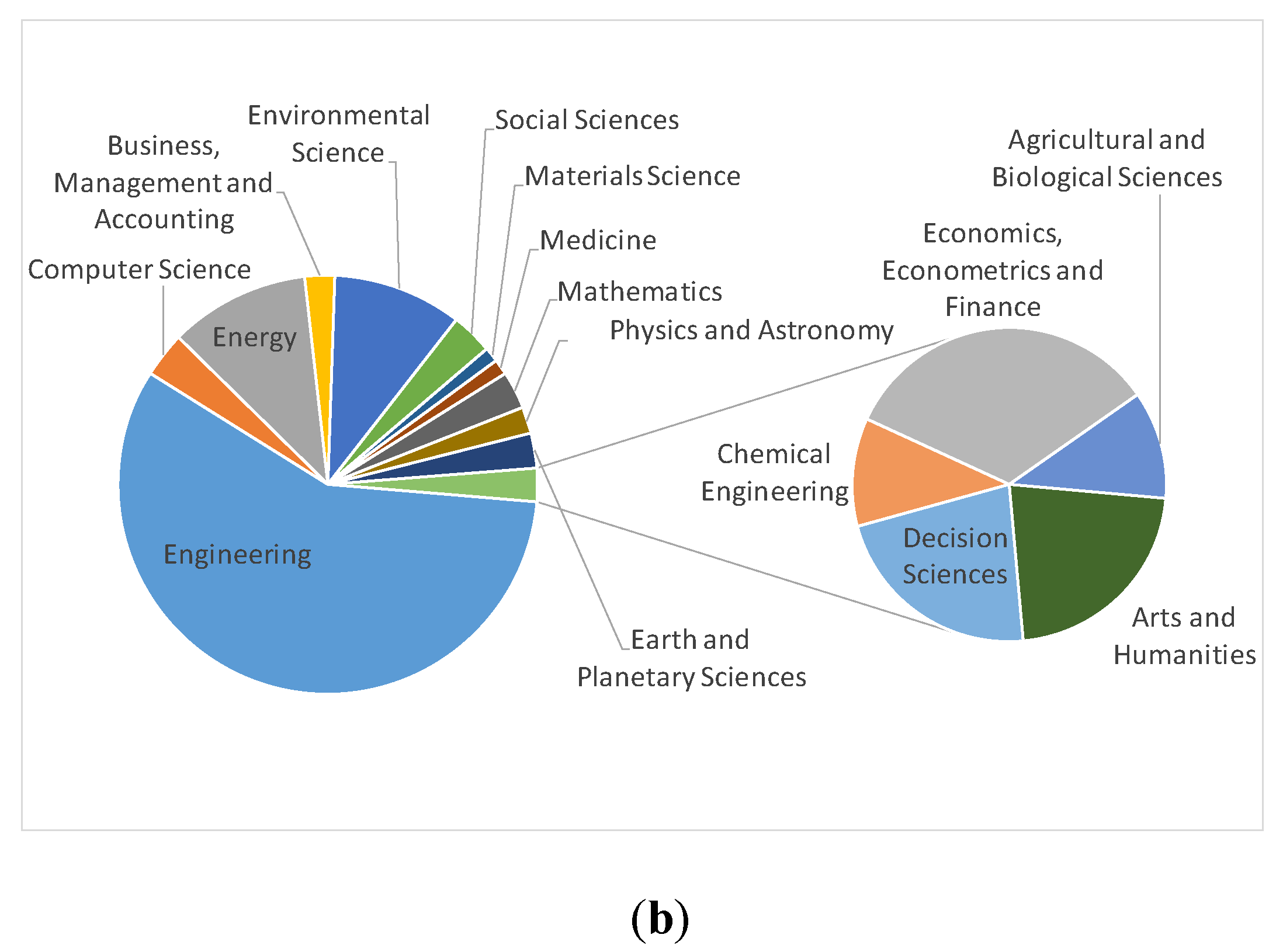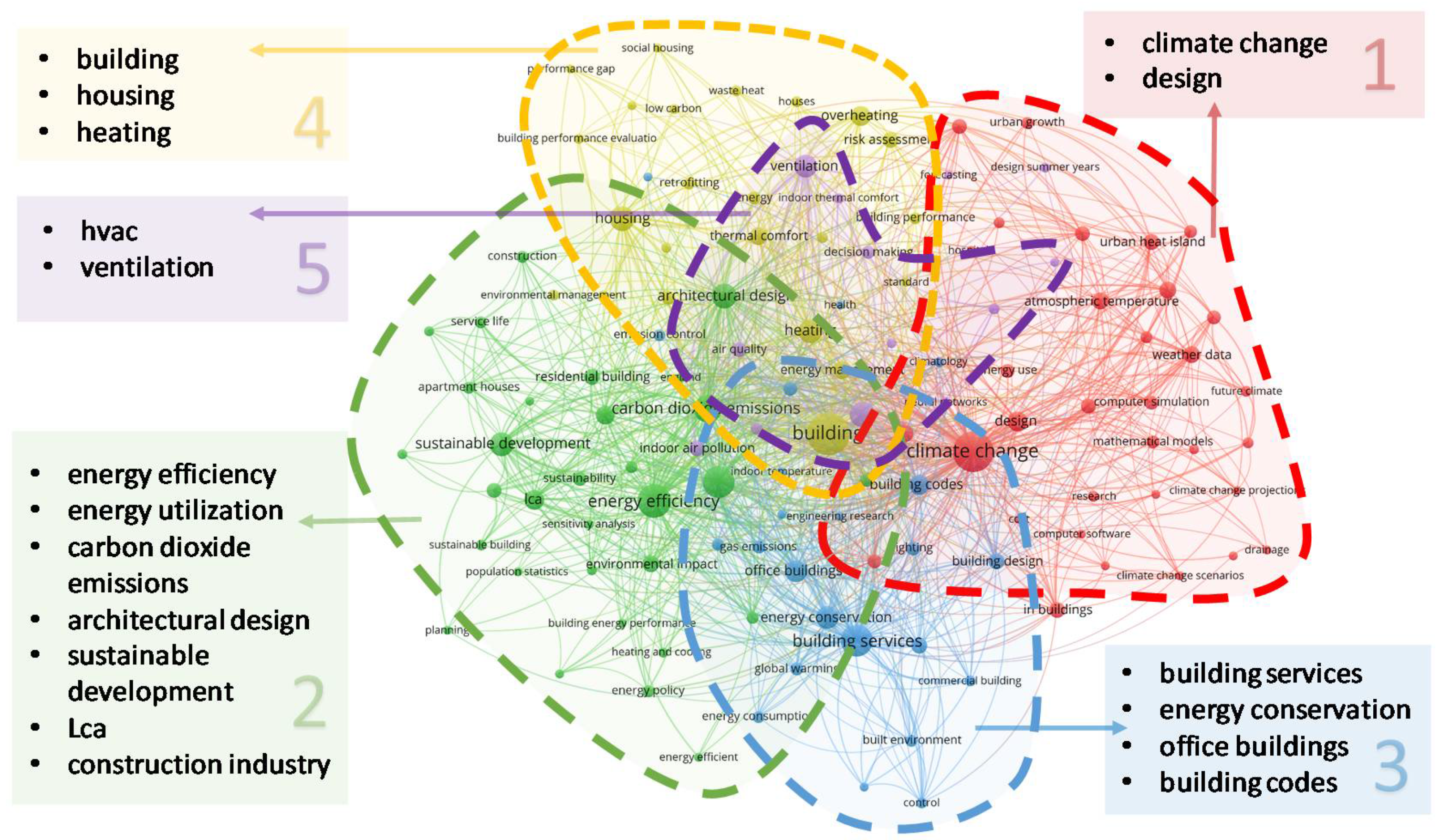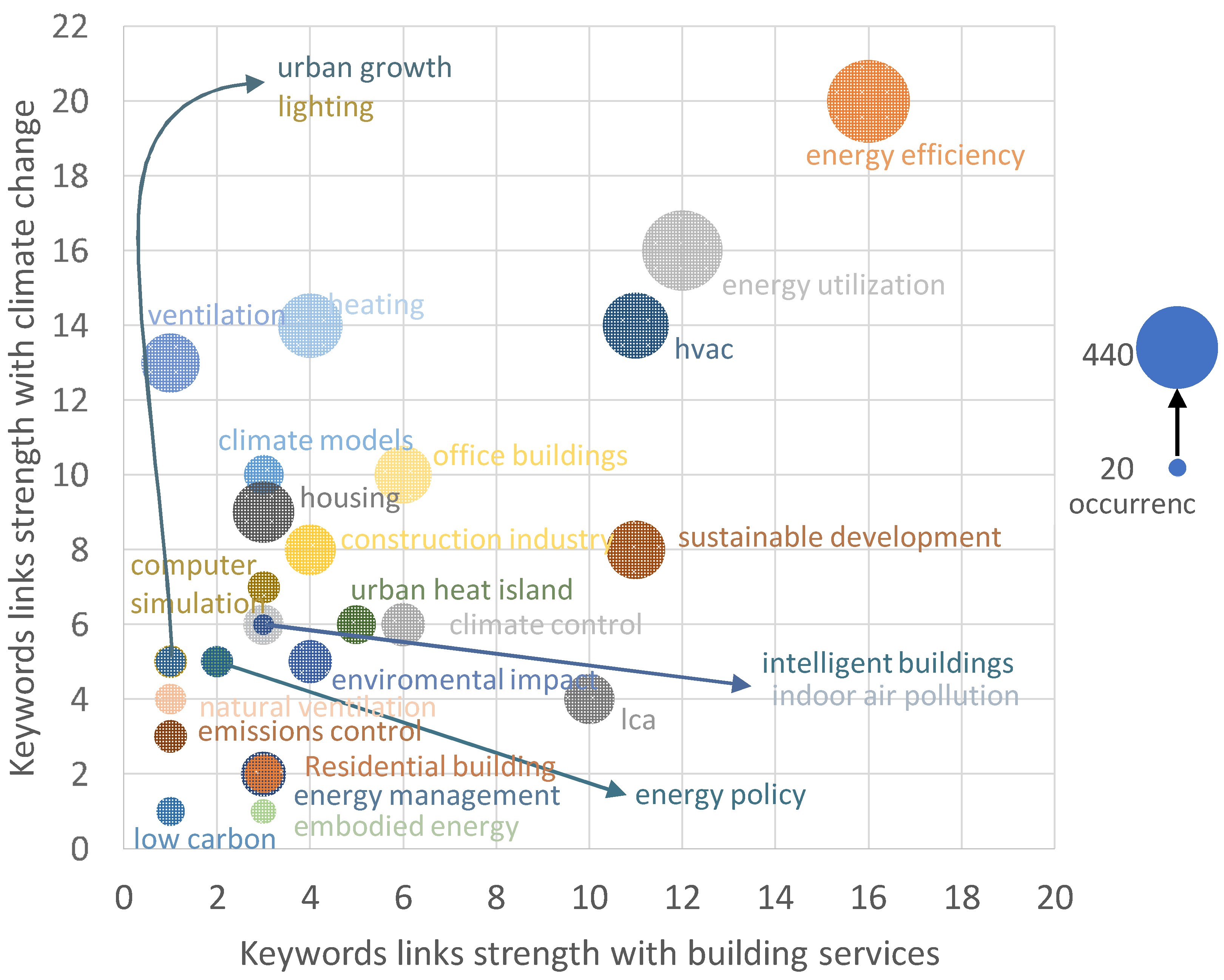Which Building Services Are Considered to Have Impact on Climate Change?
Abstract
:1. Introduction
2. Methodology
3. Results
3.1. Bibliometric Analysis
3.2. Keywords Network Analysis
4. Discussion, Past Trends and Future Perspectives
5. Conclusions
Author Contributions
Funding
Data Availability Statement
Acknowledgments
Conflicts of Interest
References
- International Energy Agency 2019. Available online: www.iea.org. (accessed on 15 December 2020).
- Ürge-Vorsatz, D.; Khosla, R.; Bernhardt, R.; Chan, Y.C.; Vérez, D.; Hu, S.; Cabeza, L.F. Advances Toward a Net-Zero Global Building Sector. Annu. Rev. Environ. Resour. 2020, 45, 227–269. [Google Scholar] [CrossRef]
- Designing Buildings Wiki. Available online: www.designingbuildings.co.uk (accessed on 7 February 2020).
- Making Buildings Better. Available online: www.bsria.com (accessed on 7 February 2020).
- Building Energy Services. Available online: https://buildingenergysrv.net/ (accessed on 7 August 2020).
- Pritchard, A. Statistical Bibliography or Bibliometrics? J. Doc. 1969, 25, 348–349. [Google Scholar]
- Wuni, I.Y.; Shen, Q.; Osei-Kyei, R. Scientometric review of global research trends on green buildings in construction journals from 1992 to 2018. Energy Build. 2019, 190, 69–85. [Google Scholar] [CrossRef]
- Cabeza, L.F.; Chàfer, M.; Mata, É. Comparative analysis of web of science and scopus on the energy efficiency and climate im-pact of buildings. Energies 2020, 13, 409. [Google Scholar] [CrossRef] [Green Version]
- van Eck, N.J.; Waltman, L. Software survey: VOSviewer, a computer program for bibliometric mapping. Scientometrics 2010, 84, 523–538. [Google Scholar] [CrossRef] [Green Version]
- Tarragona, J.; de Gracia, A.; Cabeza, L.F. Bibliometric analysis of smart control applications in thermal energy storage systems. A model predictive control approach. J. Energy Storage 2020, 32, 101704. [Google Scholar] [CrossRef]
- UNDESA. World Population Prospects: The 2010 Revision; United Nations, Department of Economic and Social Affairs, Population Division: New York, NY, USA, 2011. [Google Scholar]
- Nations, U. Unesco Science Report: Towards 2030; UNESCO: Paris, France, 2016. [Google Scholar]
- Mui, K.W.; Wong, L.T.; Yu, H.C.; Cheung, C.T.; Li, N. Exhaust ventilation performance in residential washrooms for bioaerosol particle removal after water closet flushing. Build. Serv. Eng. Res. Technol. 2017, 38, 32–46. [Google Scholar] [CrossRef]
- Huang, Z.; Liu, Q.; Liu, Y.; Pointer, M.R.; Luo, M.R.; Wang, Q.; Wu, B. Best lighting for jeans, part 1: Optimising colour preference and colour discrimination with multiple correlated colour temperatures. Light. Res. Technol. 2019, 51, 1208–1223. [Google Scholar] [CrossRef]
- Huang, Z.; Liu, Q.; Westland, S.; Pointer, M.R.; Luo, M.R.; Xiao, K. Light dominates colour preference when correlated colour temperature differs. Light. Res. Technol. 2018, 50, 995–1012. [Google Scholar] [CrossRef]
- European Climate Change Programme. Available online: https://ec.europa.eu/clima/policies/eccp_en (accessed on 20 June 2020).
- Fotios, S.; Monteir, A.L.; Uttley, J. Evaluation of pedestrian reassurance gained by higher illuminances in residential streets us-ing the day–dark approach. Light. Res. Technol. 2019, 51, 557–575. [Google Scholar] [CrossRef] [Green Version]
- Fotios, S.; Cheal, C.; Fox, S.; Uttley, J. The transition between lit and unlit sections of road and detection of driving hazards after dark. Light. Res. Technol. 2017, 51, 243–261. [Google Scholar] [CrossRef] [Green Version]
- Kent, M.; Fotios, S.; Altomonte, S. Discomfort glare evaluation: The influence of anchor bias in luminance adjustments. Light. Res. Technol. 2017, 51, 131–146. [Google Scholar] [CrossRef]
- Figueiro, M.; Kalsher, M.; Steverson, B.; Heerwagen, J.; Kampschroer, K.; Rea, M. Circadian-effective light and its impact on alertness in office workers. Light. Res. Technol. 2018, 51, 171–183. [Google Scholar] [CrossRef]
- Rea, M. Thewhatand thewhereof vision lighting research. Light. Res. Technol. 2017, 50, 14–37. [Google Scholar] [CrossRef] [Green Version]
- Rea, M.; Bullough, J.D.; Brons, J. Parking lot lighting based upon predictions of scene brightness and personal safety. Light. Res. Technol. 2015, 49, 293–304. [Google Scholar] [CrossRef]
- Zeiler, W.; Labeodan, T. Human-in-the-loop energy flexibility integration on a neighbourhood level: Small and Big Data man-agement. Build. Serv. Eng. Res. Technol. 2019, 40, 305–318. [Google Scholar] [CrossRef]
- Sayigh, A. Sustainable High Rise Buildings in Urban Zones: Advantages, Challenges, and Global Case Studies; Springer: Berlin/Heidelberg, Germany, 2016; 248p. [Google Scholar]
- Khalid, W.; Zaki, S.A.; Rijal, H.B.; Yakub, F. Investigation of comfort temperature and thermal adaptation for patients and visitors in Malaysian hospitals. Energy Build. 2019, 183, 484–499. [Google Scholar] [CrossRef]
- Chenari, B.; Carrilho, J.D.; da Silva, M.G. Towards sustainable, energy-efficient and healthy ventilation strategies in buildings: A review. Renew. Sustain. Energy Rev. 2016, 59, 1426–1447. [Google Scholar] [CrossRef]
- Eshraghi, A.; Salehi, G.; Heibati, S.; Lari, K. An enhanced operation model for energy storage system of a typical combined cool, heat and power based on demand response program: The application of mixed integer linear programming. Build. Serv. Eng. Res. Technol. 2019, 40, 47–74. [Google Scholar] [CrossRef]
- D’Oca, S.; Gunay, H.B.; Gilani, S.; O’Brien, W. Critical review and illustrative examples of office occupant modelling formalisms. Build. Serv. Eng. Res. Technol. 2019, 40, 732–757. [Google Scholar] [CrossRef]
- Kalamees, T.; Väli, A.; Kallavus, U.; Kurik, L.; Alev, Ü. Simulated influence of indoor climate and ventilation on schoolwork performance in Estonian manor schools. Int. J. Vent. 2015, 14, 153–164. [Google Scholar] [CrossRef]
- Dols, W.S.; Emmerich, S.J.; Polidoro, B.J. Using coupled energy, airflow and indoor air quality software (TRNSYS/CONTAM) to evaluate building ventilation strategies. Build. Serv. Eng. Res. Technol. 2015, 37, 163–175. [Google Scholar] [CrossRef] [Green Version]
- Vakiloroaya, V.; Samali, B.; Eager, D. Performance prediction of a new integrated central cooling plant for energy efficiency and comfort enhancement. Build. Serv. Eng. Res. Technol. 2015, 37, 379–394. [Google Scholar] [CrossRef]
- Sahamir, S.R.; Zakaria, R.; Omar, M.F.; Shakri, M.R.; Chughtai, M.W.; Mustafar, M. Energy Efficiency Criteria for Planning and Design of Green Hospital Buildings Rating System. In IOP Conference Series: Materials Science and Engineering 2019; IOP: Bristal, UK, 2019; Volume 620, p. 012082. Available online: https://iopscience.iop.org/article/10.1088/1757-899X/620/1/012082/pdf (accessed on 7 August 2020). [CrossRef]
- Bermejo-Busto, J.; Martín-Gómez, C.; Zuazua-Ros, A.; Baquero, E.; Miranda, R. Performance simulation of heat recovery ventilator cores in cascade connection. Energy Build. 2017, 134, 25–36. [Google Scholar] [CrossRef]
- Raide, I.; Kalamees, T.; Mauring, T. Õppetunnid esimestest passiivmajadeks kavandatud avalikest hoonetest Eestis. Proc. Est. Acad. Sci. 2015, 64, 157–167. [Google Scholar] [CrossRef]
- Kovári, G.; Kistelegdi, I. Building performance simulation modeling techniques. Pollack Period. 2016, 11, 135–146. [Google Scholar] [CrossRef]
- Mokhtar Azizi, N.S.; Wilkinson, S.; Fassman, E. Strategies for improving energy saving behaviour in commercial buildings in Malaysia. Eng. Constr. Archit. Manag. 2015, 22, 73–90. [Google Scholar] [CrossRef]
- Alev, Ü.; Eskola, L.; Arumägi, E.; Jokisalo, J.; Donarelli, A.; Sirén, K.; Broström, T.; Kalamees, T. Renovation alternatives to improve energy performance of historic rural houses in the Baltic Sea region. Energy Build. 2014, 77, 58–66. [Google Scholar] [CrossRef]
- Askola, J.; Çalkin, Y.; Vaskuri, A.; Poikonen, T.; Ikonen, E. Accelerated ageing of organic LED panels using ultraviolet exposure. Light. Res. Technol. 2018, 51, 1263–1274. [Google Scholar] [CrossRef]
- Davidovic, M.; Djokic, L.; Cabarkapa, A.; Kostic, M. Warm white versus neutral white LED street lighting: Pedestrians’ impres-sions. Light. Res. Technol. 2019, 51, 1237–1248. [Google Scholar] [CrossRef]
- Lu, Y.; Li, W.; Xu, W.; Lin, Y. Impacts of LED dynamic white lighting on atmosphere perception. Light. Res. Technol. 2019, 51, 1143–1158. [Google Scholar] [CrossRef]
- Raul, D.; Ghosh, K. Performance of chip-on-board and surface-mounted high-power LED luminaires at different relative hu-midities and temperatures. Light. Res. Technol. 2019, 51, 1249–1262. [Google Scholar] [CrossRef]
- Levermore, G.; Parkinson, J. The urban heat island of London, an empirical model. Build. Serv. Eng. Res. Technol. 2019, 40, 290–295. [Google Scholar] [CrossRef]
- Levermore, G.J.; Parkinson, J.B. An empirical model for the urban heat island intensity for a site in Manchester. Build. Serv. Eng. Res. Technol. 2016, 38, 21–31. [Google Scholar] [CrossRef]
- Filippín, C.; Larsen, S.F.; Ricard, F. Improvement of energy performance metrics for the retrofit of the built environment. Adaptation to climate change and mitigation of energy poverty. Energy Build. 2018, 165, 399–415. [Google Scholar] [CrossRef]
- Herrera, M.; Natarajan, S.A.; Coley, D.; Kershaw, T.; Ramallo-González, A.P.; Eames, M.; Fosas, D.; Wood, M. A review of current and future weather data for building simulation. Build. Serv. Eng. Res. Technol. 2017, 38, 602–627. [Google Scholar] [CrossRef] [Green Version]
- Devi, L.P.; Palaniappan, S. Life cycle energy analysis of a low-cost house in India. Int. J. Constr. Educ. Res. 2018, 15, 256–275. [Google Scholar] [CrossRef]
- Kovacic, I.; Reisinger, J.; Honic, M. Life Cycle Assessment of embodied and operational energy for a passive housing block in Austria. Renew. Sustain. Energy Rev. 2018, 82, 1774–1786. [Google Scholar] [CrossRef]
- Passive House Institute. Available online: https://passivehouse.com/ (accessed on 5 October 2020).
- European Commission. Progress towards Nearly Zero-Energy Buildings Uptake. Available online: https://ec.europa.eu/energy/topics/energy-efficiency/energy-efficient-buildings/nearly-zero-energy-buildings_en (accessed on 17 August 2020).
- Mitchell, R.; Natarajan, S. Overheating risk in Passivhaus dwellings. Build. Serv. Eng. Res. Technol. 2019, 40, 446–469. [Google Scholar] [CrossRef]
- Roberts, B.M.; Allinson, D.; Diamond, S.; Abel, B.; Das Bhaumik, C.; Khatami, N.; Lomas, K.J. Predictions of summertime overheating: Comparison of dynamic thermal models and measurements in synthetically occupied test houses. Build. Serv. Eng. Res. Technol. 2019, 40, 512–552. [Google Scholar] [CrossRef] [Green Version]
- Gao, X.; Zhao, T.; Luo, G.; Zheng, B.; Huang, H.; Han, X. Thermal Property Enhancement of Paraffin-Wax-Based Hydrox-yl-Terminated Polybutadiene Binder with a Novel NanoSiO2-Expanded Graphite-PW Ternary Form-Stable Phase Change Material. Energy Fuels 2018, 32, 4016–4024. [Google Scholar] [CrossRef]
- Ji, Y.; Swan, W.; Fitton, R.; Fernando, T. Assessing the requirements from ‘BB101′ 2006 and 2018 for a naturally ventilated pre-paratory school in the UK. Build. Serv. Eng. Res. Technol. 2019, 40, 638–659. [Google Scholar] [CrossRef]
- Teli, D.; Dimitriou, T.; James, P.; Bahaj, A.; Ellison, L.; Waggott, A. Fuel poverty-induced ‘prebound effect’ in achieving the anticipated carbon savings from social housing retrofit. Build. Serv. Eng. Res. Technol. 2015, 37, 176–193. [Google Scholar] [CrossRef] [Green Version]
- Gupta, R.; Kapsali, M. Evaluating the “as-built” performance of an eco-housing development in the UK. Build. Serv. Eng. Res. Technol. 2016, 37, 220–242. [Google Scholar] [CrossRef]
- Dixit, M.K. Life cycle recurrent embodied energy calculation of buildings: A review. J. Clean. Prod. 2019, 209, 731–754. [Google Scholar] [CrossRef]
- Parkin, A.; Herrera, M.; Coley, D.A. Energy or carbon? Exploring the relative size of universal zero carbon and zero energy de-sign spaces. Build. Serv. Eng. Res. Technol. 2019, 40, 319–339. [Google Scholar] [CrossRef]












| Author | Institution | Country | #doc Search | h-Index Search | Total doc | Total h-Index |
|---|---|---|---|---|---|---|
| Steve A. Fotios | University of Sheffield | UK | 39 | 13 | 120 | 20 |
| Wim Zeiler | Technische Universiteit Eindhoven | Netherlands | 32 | 4 | 171 | 15 |
| Mark S. Rea | Rensselaer Polytechnic Institute | USA | 29 | 15 | 220 | 41 |
| L.T. Wong | Hong Kong Polytechnic University | Hong Kong | 26 | 7 | 178 | 23 |
| Michael J. Davis | University College London | UK | 24 | 9 | 135 | 33 |
| Liisa Halonen | Aalto University | Finland | 24 | 11 | 75 | 18 |
| Kowk Wai Mui | Hong Kong Polytechnic University | Hong Kong | 24 | 7 | 142 | 22 |
| Ming Ronnier Luo | State Key Laboratory of Modern Optical Instrumentation | China | 23 | 8 | 129 | 16 |
| Chris Cheal | University of Sheffield | UK | 22 | 12 | 41 | 14 |
| Cheuk Ming Mak | Hong Kong Polytechnic University | Hong Kong | 21 | 8 | 203 | 24 |
| Journal | #pub | Editorial | Impact factor (2018) | Classification (2018) | Open Access |
|---|---|---|---|---|---|
| Lighting Research and Technology | 670 | SAGE Journals | 2.311 | Q2 | No |
| Building Services Engineering Research and Technology | 558 | SAGE Journals | 1.170 | Q3 | No |
| Energy and Buildings | 55 | Elsevier | 4.495 | Q1 | No |
| Facilities | 33 | Emerald Group Publishing Ltd. | --- | --- | Yes |
| Building and Environment | 23 | Elsevier | 4.820 | Q1 | No |
| Cluster | Label | Occurrences | Avg. Pub. Year | Avg. Citations |
|---|---|---|---|---|
| 1 | hvac | 248 | 2008 | 10.85 |
| ventilation | 200 | 2008 | 10.79 | |
| energy conservation | 178 | 2010 | 11.19 | |
| computer simulation | 140 | 2006 | 23.29 | |
| mathematical models | 123 | 2004 | 16.63 | |
| cooling | 108 | 2011 | 12.77 | |
| 2 | building services | 621 | 2009 | 11.89 |
| intelligent buildings | 135 | 2012 | 9.78 | |
| construction industry | 110 | 2008 | 8.14 | |
| 3 | building | 666 | 2005 | 16.54 |
| energy efficiency | 324 | 2013 | 25.08 | |
| energy utilization | 273 | 2012 | 27.60 | |
| heating | 136 | 2009 | 12.31 | |
| carbon dioxide emissions | 111 | 2013 | 15.67 | |
| housing | 108 | 2014 | 11.43 | |
| energy management | 96 | 2009 | 12.29 | |
| building codes | 87 | 2008 | 10.37 | |
| climate change | 87 | 2012 | 25.41 | |
| in buildings | 80 | 2011 | 5.33 | |
| 4 | lighting | 256 | 2013 | 15.37 |
| light emitting diodes | 129 | 2016 | 9.04 | |
| light sources | 127 | 2014 | 14.00 | |
| color | 94 | 2016 | 12.07 | |
| luminance | 92 | 2014 | 13.78 | |
| engineering research | 80 | 2014 | 8.95 | |
| 5 | office buildings | 192 | 2012 | 12.52 |
| structural design | 151 | 2008 | 8.89 | |
| design | 136 | 2012 | 8.03 | |
| lca | 89 | 2013 | 11.21 | |
| 6 | architectural design | 185 | 2013 | 9.60 |
| sustainable development | 152 | 2012 | 10.46 |
| Cluster | Label | Occurrences | Avg. Pub. Year | Avg. Citations |
|---|---|---|---|---|
| 1 | climate change | 87 | 2012 | 25.41 |
| design | 22 | 2012 | 12.86 | |
| 2 | energy efficiency | 61 | 2014 | 74.25 |
| energy utilization | 55 | 2014 | 72.11 | |
| carbon dioxide emissions | 42 | 2015 | 26.00 | |
| architectural design | 34 | 2015 | 7.62 | |
| sustainable development | 31 | 2013 | 16.13 | |
| lca | 22 | 2015 | 11.23 | |
| construction industry | 20 | 2014 | 10.30 | |
| 3 | building services | 52 | 2013 | 75.69 |
| energy conservation | 29 | 2014 | 21.14 | |
| office buildings | 25 | 2013 | 13.84 | |
| building codes | 21 | 2013 | 22.43 | |
| 4 | building | 97 | 2013 | 57.79 |
| housing | 32 | 2016 | 12.00 | |
| heating | 30 | 2014 | 19.33 | |
| overheating | 22 | 2017 | 9.50 | |
| 5 | hvac | 35 | 2013 | 14.83 |
| ventilation | 29 | 2015 | 17.69 |
Publisher’s Note: MDPI stays neutral with regard to jurisdictional claims in published maps and institutional affiliations. |
© 2021 by the authors. Licensee MDPI, Basel, Switzerland. This article is an open access article distributed under the terms and conditions of the Creative Commons Attribution (CC BY) license (https://creativecommons.org/licenses/by/4.0/).
Share and Cite
Vérez, D.; Cabeza, L.F. Which Building Services Are Considered to Have Impact on Climate Change? Energies 2021, 14, 3917. https://doi.org/10.3390/en14133917
Vérez D, Cabeza LF. Which Building Services Are Considered to Have Impact on Climate Change? Energies. 2021; 14(13):3917. https://doi.org/10.3390/en14133917
Chicago/Turabian StyleVérez, David, and Luisa F. Cabeza. 2021. "Which Building Services Are Considered to Have Impact on Climate Change?" Energies 14, no. 13: 3917. https://doi.org/10.3390/en14133917
APA StyleVérez, D., & Cabeza, L. F. (2021). Which Building Services Are Considered to Have Impact on Climate Change? Energies, 14(13), 3917. https://doi.org/10.3390/en14133917








